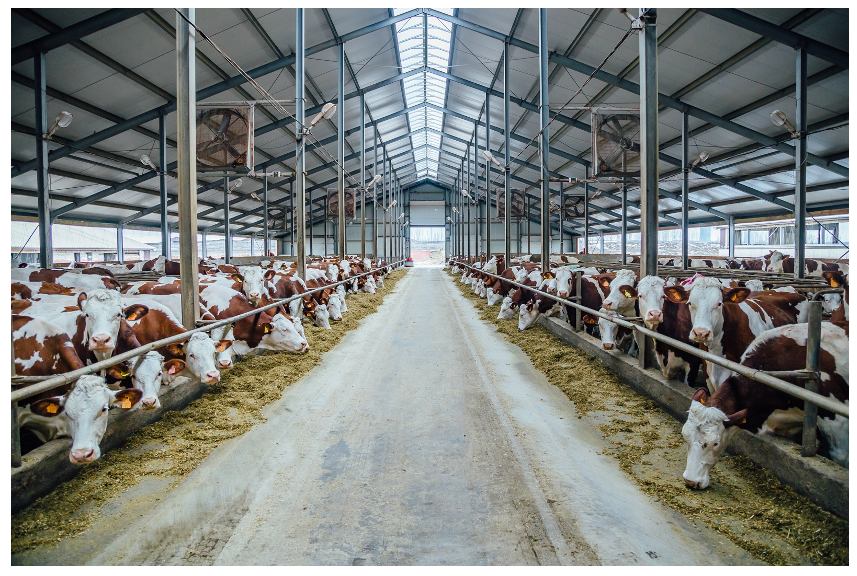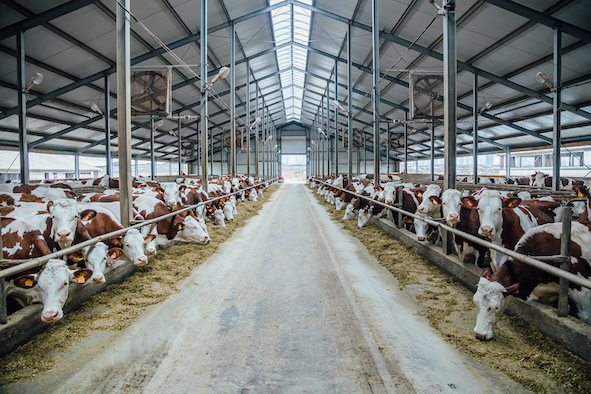Insight Focus
- Last time, we introduced you to GLEAM, the FAO’s Global Livestock Environmental Assessment Model.
- Here, we explain how we can use this to reduce emissions in livestock farming.
- These developments come at an important time, with greenhouse gas emissions still on the rise in livestock production.
The GLEAM Model
The FAO’s Global Livestock Environmental Assessment model (GLEAM) works on a key metric: kg CO2 equivalent (eq) per kg protein as a measure of intensity.
Intensity is lower in high performing livestock systems as the Greenhouse Gas (GHG) emissions are spread out of a larger volume of output (meat, milk, and eggs).
Intensity is critical to Sustainable Intensive Agriculture (SIA) as it allows for a potential reduction in herd/flock sizes. It can also allow for the repurposing of pastureland or reduce emissions from better pasture practices.
Add in other farm related mitigation, such as better manure management, and there’s considerable scope to reduce global GHG emissions, measured in kg CO2 eq.
There are other measures that can be used in intensity calculations instead of protein in the output:
- kg CO2 -eq/kg CW carcass weight (pigs, beef, broilers)
- kg CO2 -eq/kg milk (dairy cows and other ruminants)
- kg CO2 -eq/kg eggs (layers)
All these measurements are acceptable as they still provide a measure of intensity.
Improving intensity can also improve food security, an Important issue in the underdeveloped world. As an example, reducing livestock mortality rates by better health management can significantly increase intensity.
How Can We Use GLEAM?
There are three obvious ways, and many more obscure ones.
GLEAM is a comprehensive livestock model that was envisioned in 2013. It has sufficient global data to be able to model from agro-ecological zones, regions and production systems, and, in many cases, right down to an individual farm. It also includes post-farmgate CO2 modelling, such as fossil fuels for delivery, although that data is less granular than the on-farm model. One of the best parts of GLEAM is that there’s sufficient default data by regions and zones that, where data is unknown or missing, the model has usable default baseline settings. At the farm level, it allows individuals, or more likely their advisors, to do a myriad of ‘what ifs’ and assess the environmental impact of their decisions.

In the larger picture, GLEAM can be used to assess which actions or livestock types have the greatest impact. For example, in the case of dairy farming, it allows readers to focus on the issues such as slurry management or types of ingredients in the animal ration. Another example as discussed in the previous article is to identify livestock production that’s potentially the most environmentally damaging. There are, however, useful actionable conclusions for every livestock type.
Finally, GLEAM can be used to explain the broad results in a way that can be understood by those non-technical or mathematical. It allows people from many disciplines to understand the interpreted results. This is particularly important for decision makers and stakeholders who have a ‘give me the bottom line’ view of life.
How Much Environmental Mitigation Can Be Achieved in Livestock?
A lot! The GLEAM model puts global emissions at 7.1 gigatons CO2 equivalent, which is about 14.5% of all human emissions, but what if all livestock farmers adopted the best practices of their piers? The estimate is that, if producers adopted the best practices of producers with the lowest 10 to 25% of emission intensity, between 18 and 30% (1.1 to 1.8 gigatons CO2 eq) could be achieved. This is urgent as GHG volumes in livestock production are still on the rise.
By focusing on the largest issues first, the rate of mitigation can be sped up. The following areas come into focus:
- Livestock animal feed production is the largest contributor (45% of emissions), so improvements in feed conversion rates to improve intensity are a top priority. Waste is the enemy of SIA and not getting the maximum output from livestock is a type of waste. Improved genetics and animal health are included in this.
- Enteric fermentation of methane is the second largest contributor at 39%. This means beef and dairy animals, buffalo, and, to a lesser degree, small ruminants should be focussed on.
- Manure storage and processing represents a further 10%. This is spread across species, but ruminants are an important part of this.
- The expansion of pasture, especially into forests, and crops grown for livestock feed, particularly soybean, contribute a further 9%. In some ways, it is the most insidious as it produces GHG from growing the related crops and robs us of valuable carbon sinks. In the case of pasture expansion, it would be far better to concentrate on improved grassland management on the current available land, where significant improvements can be made.
In the list above, it becomes clear that ruminants are the obvious starting point in our journey to examine mitigation methods, although there are opportunities to be found elsewhere in monogastrics and particularly in pork production in some parts of the world. Ruminants are also complex because of their ability to better convert cellulose into energy than monogastrics and because they’re fed on grass and other forage crops such as maize silage, as well as on bought in feed.

The GLEAM model does not consider lifestyle choices such as substation of meat or milk with plant-based alternatives. Particularly in the case of milk, there are important nutritional and health benefits to consider. which also contribute to wellbeing and food security, particularly in the underdeveloped world.
What About Scientific Developments?
Running in parallel to the improvements suggested by GLEAM is the progress from science. They will of course show up in the model. There are many new innovations becoming available, particularly in livestock feed. Examples are products to reduce enteric fermentation, adding synthetic amino acids and replacing plant protein, such as that from soybean meal.
Other Insights That May Be of Interest
Sustainable Agriculture: Building a More Sustainable Livestock Sector
